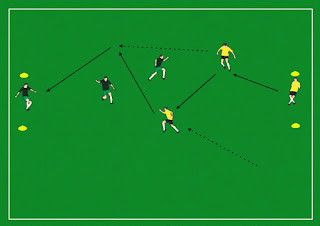U10 game modifications
The U10 game is the first one that incorporates a referee, player passes and a game card. It is also the first age group that keep tracks of results. When I first started working with the Impact, I observed lots of U10 games and as a result, I came up with a couple of modifications to emphasize skill and possession. There is NO PUNTING in U10. When the GK gets the ball under control, the last thing we want to have him/her do is to kick the ball away. When the GK does punt the ball, the other team gets possession about 80% of the time. In addition, players have a hard time judging the speed and direction of the ball, so when the ball is in the air, they either cower from the ball, try to play it with their head or let it bounce over their head. None of these results makes it easy for the attacking team to retain possession. Instead of punting, the GK can throw the ball, roll the ball to a teammate or put it on the ground and pass it to a teammate. the GK's most important job i
